Ahrefs offers a $7 seven-day trial with full access to either their Lite or Standard plan. Either plan offers everything you could possibly want if you work for a single company and not an SEO agency.
The trial gives users unfettered access to the ahrefs system. In this post, you’ll learn how to maximize that trial to set up your marketing and content team for months to come. Today we will cover how to set up a project, perform a site audit, benchmark a domain, check competitors, find low competition keywords, and finally how to develop an actionable plan.
Set up a Project
Setting up a project allows you to capture actionable data about the site. The site’s stats then reside on your home screen for handy viewing any time you log on.
To set up a project, simply click on the “New Project” button on the home screen.
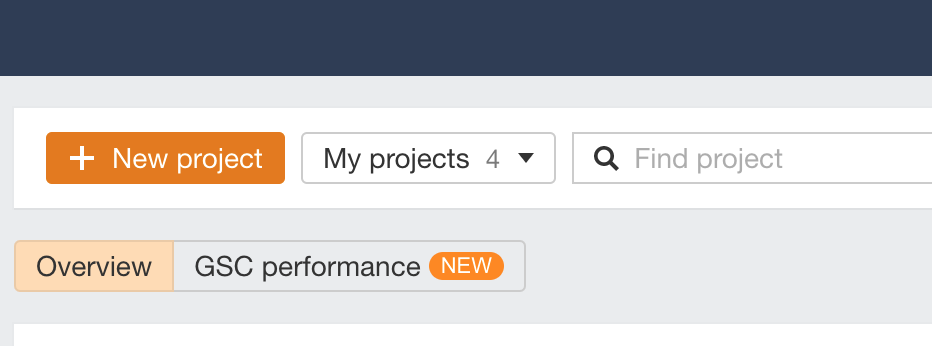
After clicking on adding a new project, you can either add your site manually or import from Google Search Console. Go with the manual option. While the ahrefs trial provides a great tool, there’s no need to deanonymize your niche’s real traffic so it can be freely shared with other competitors. You will click through a few menus asking if you want to perform a crawl and evaluate keywords.
The important aspect here is to perform that site crawl, also known as an audit.
The Site Audit
A site audit quickly provides tangible value and action items on which you can take action. Issues such as slow load speeds, dead-end pages, broken links, and bad headings are quickly identified. Every site receives an overall score from 0-100. More importantly, you’ll receive an action item list of corrections to make to your site.
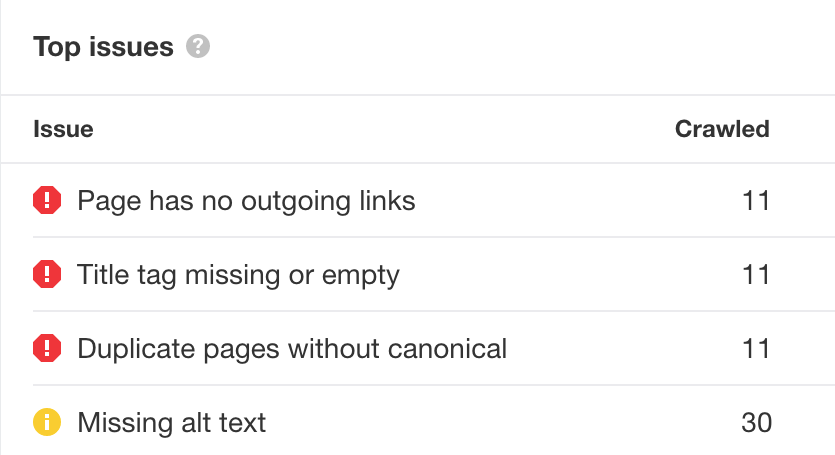
There’s a handy function to print that list to PDF and distribute it amongst your team. If you’ve got a savvy developer and content manager on staff, nearly all problems identified by the audit should be quickly rectified.
Benchmark Your Domain
Ahrefs provides a toolbar that shows crucial SEO information about your site. When you added your site as a project, you received this information on your dashboard.

Each of the displayed variables provides an insight into your site’s search engine optimization (SEO) power. Here’s how to interpret each one as well as its relative importance.
Ahrefs Rank
All websites rank in the ahrefs database by the size and quality of their backlink profile. The more and higher quality backlinks a website has, the higher its rank.
Metric usefulness: 2/5 – This is the same metric as DR – only more cryptic. I guess it’s kind of cool to know you are the 7 millionth most powerful site on the web….or is it?
DR
DR, or domain rating, shows the strength of a website’s backlink profile compared to others on a 100-point scale. This 100 point scale also reports on a logarithmic scale. The DR shows as higher than UR if external linking falls frequently on child pages rather than the home page.
Metric usefulness: 4/5 – An easier way to understand your site’s power vs. Ahrefs rank, which in turn makes it easy to figure out which keywords to chase and how to evaluate competitors that are fighting over the same keywords.
UR
This estimated power rating pertains to the individual page that’s being examined. Individual pages of a domain may be examined and not just the homepage.
Metric usefulness: 3/5 – The DR rating provides a clear and general indicator of how much power your site has to lack, which then influences future keyword selections. The UR rating is more of a backward–looking metric – it informs a page’s individual power. However, it does have use when determining which pages may require external link boosters.
Backlinks
The total number of backlinks to your site influences the site’s ranking. Ideally, these backlinks should be “do-follow” and from a reputable site with good domain authority.
Metric usefulness: 2/5: Honestly I never look at the volume of backlinks. It’s certainly a positive ranking indicator, but domains matter more. Backlink volume does play a role and where the backlink points. (i.e. links in the footer matter less, a site that provides 30 backlinks to your site has more weight than just a single one).
Referring Domains
The backbone of external SEO always leads back to external links. Drilling down into this number shows all domains that link to the site.
Metric usefulness: 4/5: Understanding your backlink profile and how you acquired those backlinks helps inform your go-forward external SEO strategy.
Organic Keywords
Organic keywords show what keywords the site currently ranks for. This information provides a guide for additional content building as the Google bot likes to rank content that’s similar to content that’s already ranking. In SEO parlance, developing content in such a manner is called keyword clustering.
Metric usefulness 5/5: Knowing what organic keywords you rank for unfurls a world of possibilities. It informs future content planning and helps you understand current content performance.
Organic Traffic
Organic traffic provides an estimated amount of traffic. From my findings, these numbers can be significantly off, particularly for low-volume sites that rank for very long-tail keywords. An important thing to remember about ahrefs.com is it’s a reverse-engineered bot to duplicate the Google bot. Duplicating such a widespread and sprawling bot is bout to have its challenges. And organic traffic seems to be one of those challenges with which ahrefs.com struggles.
Metric usefulness 3/5: A decent metric for a rough cut evaluation of site traffic – particularly for sites that you don’t own. For sites you own, Google Analytics provides much more trustworthy intel.
Traffic value
This feature of the ahrefs trial informs you how much you would have to pay for that organic traffic if you bought keywords instead.
Metric usefulness 1/5: It provides a fun metric yet in my experience provides no real actionable value.
Compare Yourself with Competitors
You likely have an idea who your main competitors are. But you might be surprised. If your site attracts a lot of traffic, sign into your ahrefs trial, pull up your site, and click on “Competing Domains”. This gives you an indication of who competes in the same keyword space. You can take a lot at the search terms for which they rank. And start plotting for the takeover of those rankings… 🙂
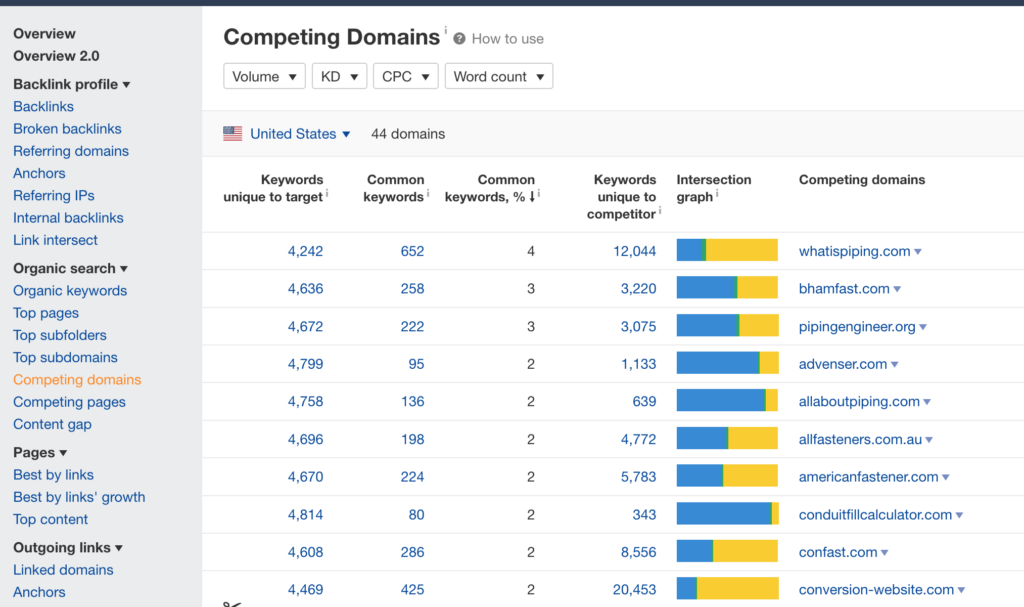
So, digging up a bit of dirt on your competitors is cool. But it pales in value to the next step….finding low competition keywords.
Finding Low Competition Keywords
You might already have a few ideas in your head for keywords that you wish to rank for. The ahrefs trial allows for 175 individual searches per 7 days, but each individual search can be hundreds of terms. So come up with a big list of everything you think your potential customers might want to know. And then pop them all into the Keywords search bar.
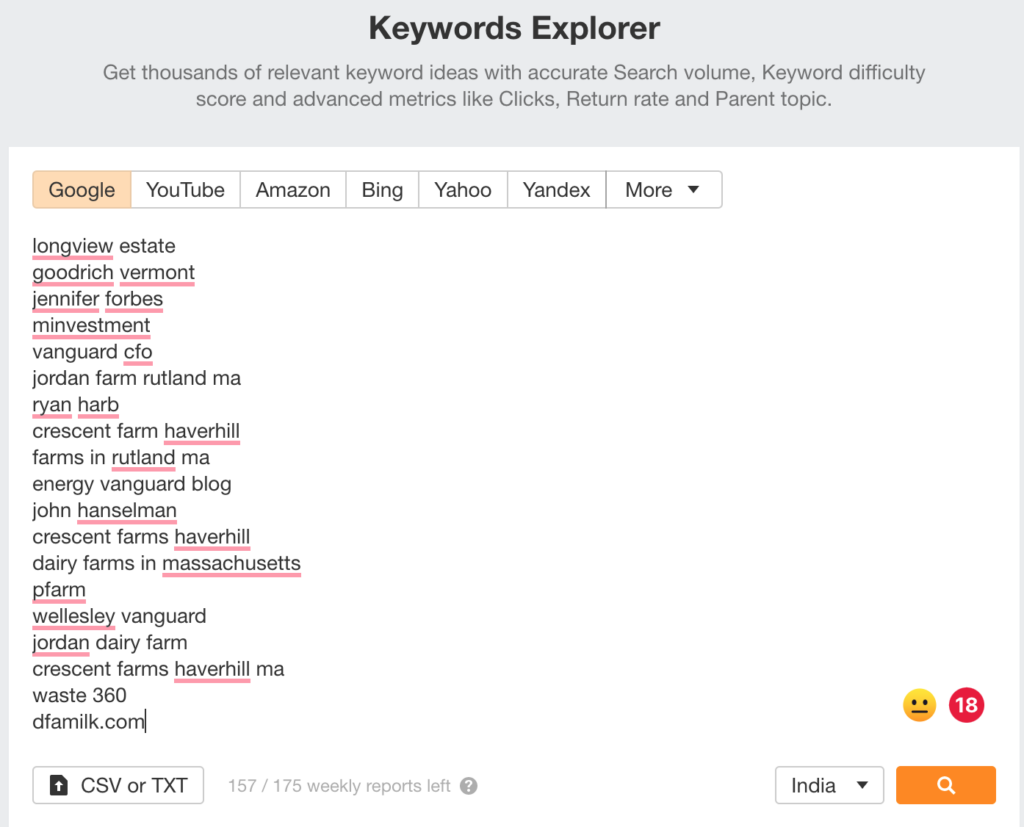
The intel you receive on these keywords is highly instructive. For instance, the term below has a keyword difficulty of 45 on a 0-100 logarthitmic scale. This means achieving a high rank will be fairly difficult. The volume shows for your selected country, GV equates to global volume, and TP means traffic potential. Why would traffic potential vary so much from search volume? Some terms attract additional traffic outside their chosen keyword. Some terms have little relation to other keywords.

Develop an Internal and External SEO Plan
Everything you just accomplished with the ahrefs trial is completely worthless without a plan. A good SEO plan involves two factors:
- Internal SEO Strategy
- External SEO Strategy
Internal SEO Strategy
Remember when you ran a site audit and found your domain ranking score as well as organic traffic? This information gives you a level and is instructive of the type of terms you can rank for. Why would Google trust a low-power, low-traffic site with a massive keyword? It won’t. Nobody rolls out of bed and ranks a search term like “best car” even if you throw 1.5 million backlinks at it.
At a speakeasy near the bay in San Francisco a half-decade ago, I bumped into Keyword Sensei, known in Silicon Valley simply as K See. Immediately recognizing him and stunned he was more than just a myth, I asked for his best possible advice. Swirling his martini, he grumbled a single sentence that has since been the cornerstone of my future strategy:
Take the number of organic traffic your site receives per day. Target keywords at that monthly search volume level and over.
Keyword Sensei
So if your site currently receives 100 organic visitors a day, then target terms that receive 100 searches or more a month. Look for key terms that have a difficulty level of 10 and below. In that type of range, if you are cultivating well-written content, you should be able to immediately rank for articles once they are published.
But don’t focus strictly on low competition keywords. Seeing that high-competition keywords are searched more frequently, they are good candidates for attracting external links. Even if you lack authority and brand equity, if you have enough high-quality backlinks to your website, you might be able to rank. And even if you don’t rank, there are two further advantages to targeting high-competition keywords.
External SEO Strategy
Use ahrefs.com to quantify sites that might be useful for backlinks. Don’t bother with sites with a DR of 10 or below. The higher the DR the better, as achieving links from these sites boost your own ranking power and potential to show up in search results. Keep in mind that backlinks group into two types: do-follow and no-follow. You can determine which type a site tends to give out by checking “Linked domains” on the sidebar menu.
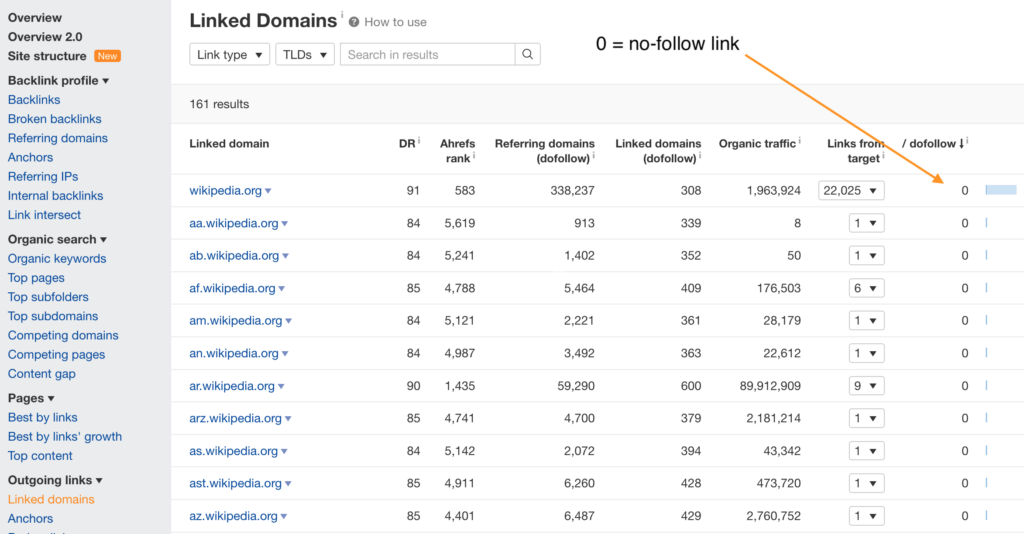
Want to devise a detailed actionable plan based on what you just read? Check out our article “SEO for Industrial Companies.”